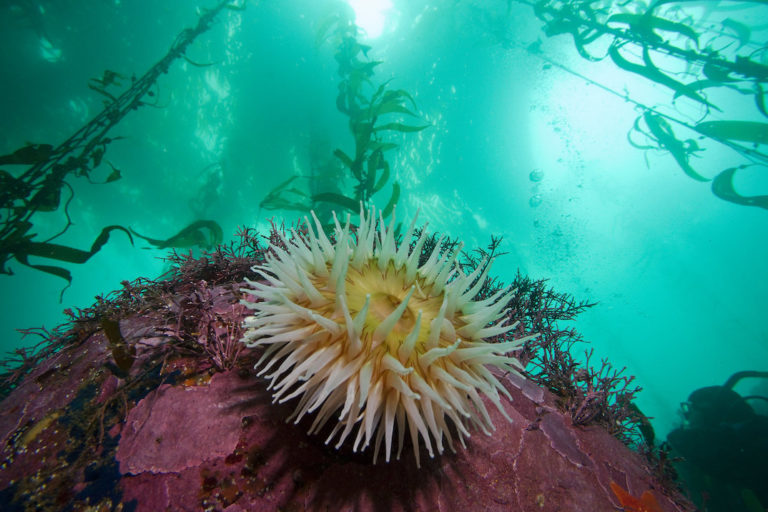- During December 2022, California is holding its first 10-year review of its marine protected areas network, to be used to inform the network’s future.
- Previously, Gov. Gavin Newsom laid out a goal to protect 30% of the state’s land, water, and sea space over the decade.
- “As state regulators take account of the progress it has made of protecting marine ecosystems and wildlife, California should expand and strengthen upon its MPA success stories to ensure 30% of its state waters are fully protected by 2030,” a new op-ed argues.
- This post is a commentary. The views expressed are those of the author, not necessarily Mongabay.
California’s iconic coastline has long captivated the world’s imagination. Beyond its shores, hidden beneath the waves, stretches a vast, mysterious wilderness containing some of the most diverse ecosystems on the planet. For the past decade, California has been at the forefront of a global movement to conserve ocean biodiversity through marine protected areas (MPAs). Since the state’s marine protected area (MPA) network was completed in 2012, California is home to 124 MPAs covering approximately 852 square miles – a little over 16% of the state’s ocean waters.
In December 2022, California will hold its first 10-year review of its MPA network. The review will be used to inform the network’s future. Earlier this year, California Gov. Gavin Newsom laid out a goal to protect 30% of the state’s land, water, and sea space over the decade. As state regulators take account of the progress it has made of protecting marine ecosystems and wildlife, California should expand and strengthen upon its MPA success stories to ensure 30% of its state waters are fully protected by 2030.
MPAs are regions of the ocean and coastline legally protected from human exploitation. These zones can have varying levels of protections: MPA can include everything from lightly protected areas that only prohibit drilling and mining to highly protected zones where commercial fishing is banned, to fully protected “no-take” zones where all extractive activities are completely off-limits.
A growing body of research demonstrates that MPAs – and fully protected no-take zones in particular – can have real impacts in conserving biodiversity and enabling wildlife to live and flourish. In California, researchers have found clear evidence that California’s investment in MPAs is already making a difference. Environment California Research & Policy Center and Azul’s recent report “Changing the Tides: How Marine Protections Cultivate Ocean Life,” has highlighted examples of marine ecosystem recovery in five of California’s most iconic MPAs.
The Point Lobos State Marine Reserve, in particular, provides a compelling success story of California’s ocean conservation efforts. Located off the coast of Monterey County, countless generations of sea otters, sea lions and harbor seals have long flocked to Point Lobos’ rocky shoreline. More than 300 species of birds thrive above the coldwater corals that populate its rocky reefs. Beneath the water, vast eelgrass beds and kelp forests house abundant fish species, including California halibut and rainbow sea perch, and Dungeness crabs and brittle sea stars on the sandy seafloor.
The abundance of life in this patch of ocean is attributable in large measure to the longstanding marine protections that exist there. The Point Lobos Ecological Reserve was first created in 1974. By 2007, the Point Lobos State Marine Reserve (SMR) and Point Lobos State Marine Conservation Area (SMCA) were among the first MPAs designated as a result of the Marine Life Protection Act. Point Lobos is composed of both a fully protected, no-take zone and a highly protected area off-limits to many extractive activities.
The long-term protections highlight how setting aside areas free from fishing can have dramatic results for ocean life. Abalone – a species of sea snail once numbering in the millions along California’s coast but harvested almost to extinction – is a case in point. A 2013 study of California’s MPAs found that the endangered black abalone increased in numbers and size inside MPAs within five years of protections being implemented.
Research on Point Lobos also demonstrates the impact of long-term protections. A 2008 study of central coast marine reserves, including Point Lobos, found that sites protected for at least 25 years had significantly larger black abalone individuals and significantly more red abalone than unprotected areas.
The report also looks at how the threatened Western Snowy Plover benefits from protections at the Campus Point State Marine Conservation Area off the coast of Santa Barbara. A deeper look here reveals how marine protections have cascading effects that benefit species onshore. Habitat loss, increases in introduced predators and human disruption of nesting sites have put a tremendous strain on the snowy plover. In 1993, the U.S. Fish and Wildlife Service listed the species as threatened. By 2016, in Los Angeles County, their population consisted of a mere 140 birds. Snowy plovers were disappearing.

Campus Point State Marine Conservation Area (SMCA) was established in 2012 and is a key nesting site for the western snowy plover. All harvesting of living species is prohibited in this 10.5-mile area of ocean, and the area is protected from major human disturbances such as offshore oil drilling.
A study conducted between 2019 and 2021 to assess the effects of MPAs on beaches and surf zones throughout California’s MPA network found that average numbers of these birds were more than 30% higher at MPA sites than unprotected areas, and it was at Campus Point that the highest number of snowy plovers seen in a single survey during the study – 94 birds – was observed. The relative abundance of the threatened western snowy plover at Campus Point is an indicator of the indirect effects felt onshore of protected areas in the water. With the implementation of protections, scientists saw a decline in red sea urchins – which are animals that decimate kelp forests if left unchecked – off Campus Point. This reduction will lead to healthier kelp forests, better balanced ecosystems and more kelp washing to shore for eager plovers to hunt for food.
The relative abundance of snowy plover at Campus Point is also an indicator of indirect effects of MPA protections offshore. A kelp forest ecosystem thrives farther out to sea, and dislodged kelp washes ashore. Following the implementation of protections, red sea urchin numbers declined at Campus Point, in turn suggesting that the amount of kelp is increasing, since sea urchins eat kelp and an overabundance of urchins can decimate kelp forests. When kelp washes ashore, it delivers food to these wading shorebirds who pick through its folds for flies and crustaceans that depend on the kelp for their own home. The interconnectedness of this system shows why no-take MPAs are so important, since they protect a complex and interwoven food web.
In short, California’s MPA network is working. Highly- and fully-protected MPAs provide marine ecosystems with the habitat and resources needed to support California’s rich species biodiversity. The proven successes of California’s network of MPAs has created a model that can be emulated both in the United States and abroad.
Having seen what these protections can do, however, it is now time to strengthen them. In line with the state’s 30×30 initiative, it is time to expand California’s network of marine reserves to ensure that 30% of state waters are covered by fully or highly protected MPAs by 2030. By strengthening existing protections of larger ocean spaces, we can minimize our footprint on the ocean and reverse some of the damage we’ve done to this watery wilderness over the last century.
Ben Grundy leads Environment California’s campaigns to tackle conservation issues at the local and state level.
See related reading:
Strong marine protected areas credited with manta ray surge in Indonesia
This story first appeared on Mongabay
South Africa Today – Environment
This article is licensed under a Creative Commons Attribution-NoDerivatives 4.0 International License.
You may republish this article, so long as you credit the authors and Mongabay, and do not change the text. Please include a link back to the original article.












